Experimental methods for studying particles. Physics presentation. Wilson chamber. Geiger counter. The bubble chamber The cloud chamber can be called a “window” into the microworld. It is a hermetically sealed vessel filled with water vapor or steam.
Gas-discharge Geiger counter. The basis of the Geiger counter is a tube filled with gas and equipped with two electrodes, to which a high voltage is applied. The operation of the counter is based on impact ionization. When an elementary particle flies through the counter, it ionizes the gas, and the current through the counter increases very sharply. The voltage pulse formed at the same time on the load is fed to the recording device.
slide 5 from the presentation "Methods for Particle Research". The size of the archive with the presentation is 956 KB.Physics Grade 9
summary of other presentations"Sound and its characteristics" - Cutter. Pure tone. Pitch. Overtones. Sound volume. Lightning. The meaning of sound. Sound and its characteristics. What is sound. Sound sources. Brick. Low baritone. Ultrasound. Interesting tasks. Unit of measurement. The speed of sound waves. Sound propagation. Thunder boomed. Speed. Fly of butterfly. infrasound. Complex sound.
"Safety of nuclear energy" - Scheme of a boiling nuclear reactor. Scheme of operation of a boiling nuclear reactor. Nuclear reactor. Nuclear power plants have more opportunities in energy production. Nuclear power plants on the map of Russia. From the history of nuclear energy. Thermonuclear fusion. Safety. Benefits and harms of nuclear energy. Harm of nuclear energy. Nuclear icebreakers. Nuclear power plants. Nuclear power. The reaction of the decay of uranium nuclei.
"Application of nuclear energy" - Powerful radiation. Irradiation of seeds. A method for monitoring the wear of parts. Biological effect of radioactive radiation. Nuclear reactors. Protection of organisms from radiation. The use of nuclear energy. Nuclear weapon. radioactive isotopes. Development of nuclear energy. equivalent dose. X-ray. Obtaining radioactive isotopes. Potential Threat. Age of archaeological finds. What is radiation dose.
"The principle of a nuclear reactor" - In our country, the first nuclear reactor was launched on December 25, 1946. Nuclear reactor. Chain reaction of fission of some heavy nuclei. Repetition. The first nuclear reactors. Energy conversion. Types of reactors. The main elements of a nuclear reactor. What energy transformations take place in a nuclear reactor. In 1946, the first nuclear reactor was built in the Soviet Union. What mass of uranium is critical.
"Tasks "Magnetic field"" - Magnetic needle. Currents in opposite directions. Directions of Ampere's force. Determine the position of the poles of the magnet. Conductor with current. Electric charge is moving. Electric field. Straight conductor with current. Left hand rule. Determine the direction of current in the conductor. Determine the direction of Ampere's force. Two parallel conductors. How will two parallel conductors interact with each other.
""The force of friction" Grade 9" - A study of the force of friction and its role in human life. Historians. Introduction. Friction. During the 18th and 19th centuries, there were up to 30 studies. Friction is blamed for making it difficult to walk. Knowledge of the phenomenon of friction. Research team report. Experimenters. Collectors of folklore. Trial of friction. Educational project. Report of a group of experimenters. The task of practitioners. The dependence of the friction force on the size of irregularities.
slide 1
Experimental methods for studying particles. Geiger counter Municipal educational institution "Secondary school No. 30 of the city of Belovo" Completed by: Voronchikhin Valery, Makareikin Anton Pupils of the 9th "B" class Supervisor: Popova I.A., teacher of physics Belovo 2010slide 2
 Geiger counter The widespread use of the Geiger-Muller counter is explained by its high sensitivity, the ability to register various types of radiation, the comparative simplicity and low cost of installation. The counter was invented in 1908 by Geiger and improved by Muller. The sensitivity of the counter is determined by the composition of the gas, its volume, and the material (and thickness) of its walls.
Geiger counter The widespread use of the Geiger-Muller counter is explained by its high sensitivity, the ability to register various types of radiation, the comparative simplicity and low cost of installation. The counter was invented in 1908 by Geiger and improved by Muller. The sensitivity of the counter is determined by the composition of the gas, its volume, and the material (and thickness) of its walls.
slide 3
 The principle of operation of the device Geiger counter consists of a metal cylinder, which is the cathode, and a thin wire stretched along its axis - the anode. The cathode and anode are connected through resistance R to a high voltage source (200-1000 V), due to which a strong electric field arises in the space between the electrodes. Both electrodes are placed in a sealed glass tube filled with rarefied gas.
The principle of operation of the device Geiger counter consists of a metal cylinder, which is the cathode, and a thin wire stretched along its axis - the anode. The cathode and anode are connected through resistance R to a high voltage source (200-1000 V), due to which a strong electric field arises in the space between the electrodes. Both electrodes are placed in a sealed glass tube filled with rarefied gas.
slide 4
 If the electric field strength is high enough, then the electrons acquire a sufficiently large energy over the mean free path and also ionize gas atoms, forming new generations of ions and electrons that can take part in ionization. An electron-ion avalanche is formed in the tube, as a result of which there is a short-term and sharp increase in the current strength in the circuit and the voltage in the resistance R. This voltage pulse, indicating that a particle has entered the counter, is recorded by a special device.
If the electric field strength is high enough, then the electrons acquire a sufficiently large energy over the mean free path and also ionize gas atoms, forming new generations of ions and electrons that can take part in ionization. An electron-ion avalanche is formed in the tube, as a result of which there is a short-term and sharp increase in the current strength in the circuit and the voltage in the resistance R. This voltage pulse, indicating that a particle has entered the counter, is recorded by a special device.
slide 5
 The Geiger counter is mainly used to register electrons, but there are models that are also suitable for registration - gamma quanta.
The Geiger counter is mainly used to register electrons, but there are models that are also suitable for registration - gamma quanta.
Gas discharge Geiger counter
R To amplifier Glass tube Anode Cathode The gas-discharge counter has a cathode in the form of a cylinder and an anode in the form of a thin wire along the axis of the cylinder. The space between the cathode and the anode is filled with a special mixture of gases. A voltage is applied between the cathode and anode.
Scintillation counter
Cherenkov counter Scheme of the Cherenkov counter: on the left - the cone of Cherenkov radiation, on the right - the device of the counter. 1 - particle, 2 - particle trajectory, 3 - wave front, 4 - radiator, 5 - PMT (the development of an avalanche of secondary electrons caused by a photoelectron is shown), 6 - photocathode.
cloud chamber cloud chamber. A container with a glass lid and a piston at the bottom is filled with saturated vapors of water, alcohol or ether. As the piston descends, due to the adiabatic expansion, the vapors cool and become supersaturated. A charged particle passing through the chamber leaves a chain of ions in its path. The vapor condenses on the ions, making the trace of the particle visible.
The first charged particle detector, the cloud chamber, was created on April 19, 1911. The chamber was a glass cylinder with a diameter of 16.5 cm and a height of 3.5 cm. The top of the cylinder was covered with glued mirror glass, through which the traces of particles were photographed. Inside was the second cylinder, in it - a wooden ring, lowered into the water. Evaporating from the surface of the ring, it saturates the chamber with water vapor. The vacuum pump created a vacuum in a spherical container connected to the chamber by a tube with a valve. When the valve was opened, a rarefaction was created in the chamber, the water vapor became supersaturated, and on the traces of charged particles they condensed in the form of fog strips (which is why the device is called the cloud chamber in foreign literature)
bubble chamber. The container is filled with well-purified liquid. There are no centers of vapor formation in the liquid, so it can be superheated above the boiling point. But the passing particle leaves behind an ionized trail, along which the liquid boils, marking the trajectory with a chain of bubbles. Modern chambers use liquid gases - propane, helium, hydrogen, xenon, neon, etc. In the picture: a bubble chamber designed at FIAN. 1955–1956 bubble chamber
Photograph of the collision of sulfur and gold ions in a streamer (a type of spark) chamber. The tracks of charged particles born during collisions in it look like chains of separate non-merging discharges - streamers.
spark chamber
Particle track in a narrow-gap spark chamber Particle tracks in a streamer spark chamber
Method of thick-layer photographic emulsions Charged particles create latent images of motion traces. The length and thickness of the track can be used to estimate the energy and mass of the particle. The emulsion has a high density, so the tracks are short.
We got acquainted with the description of the devices most widely used in the study of elementary particles and in nuclear physics.
Completed by: Andreyenko Andrey
Gomel 2015

The Geiger-Muller counter was invented in 1908 by G. Geiger, later improved by W. Müller, who implemented several varieties of the device .. It contains a chamber filled with gas, therefore this device is also called gas-filled detectors.

Principle of operation of the counter The counter is a gas-discharge volume with a highly inhomogeneous
electric field. Most often, counters with coaxial cylindrical electrodes are used:
the outer cylinder is the cathode and a thread with a diameter of 0.1 mm stretched on its axis is the anode. The internal, or collecting, electrode (anode) is mounted on insulators. This electrode is usually made of tungsten, which makes it possible to obtain a strong and uniform small diameter wire. The other electrode (cathode) is usually part of the meter shell. If the walls of the tube are glass, its inner surface is covered with a conductive layer (copper, tungsten, nichrome, etc.). The electrodes are located in a hermetically sealed tank filled with some gas (helium, argon, etc.) up to a pressure of several centimeters to tens of centimeters of mercury. In order for the transfer of negative charges in the counter to be carried out by free electrons, the gases used to fill the counters must have a sufficiently low electron sticking coefficient (as a rule, these are noble gases). To register particles with a short range (α-particles, electrons), a window is made in the counter tank through which the particles enter the working volume.

a - end, b - cylindrical, c - needle, d - jacketed counter, e - plane-parallel

Geiger counters are divided into non-self-extinguishing and self-extinguishing counters.
External discharge suppression circuit.
In gas-filled counters, positive ions travel all the way to the cathode and are neutralized near it, pulling electrons out of the metal. These additional electrons can lead to the next discharge if steps are not taken to prevent and extinguish it. The discharge in the counter is extinguished by the inclusion of a resistance counter in the anode circuit. In the presence of such resistance, the discharge in the counter stops when the voltage between the anode and cathode decreases due to the collection of electrons at the anode to values less than those necessary to maintain the discharge. A significant disadvantage of such a scheme is the low temporal resolution, on the order of 10−3 s or more.

Self-extinguishing counters.
At present, non-self-extinguishing meters are rarely used, since good self-extinguishing meters have been developed. Obviously, in order to stop the discharge in the counter, it is necessary to eliminate the causes that maintain the discharge after the passage of the ionizing particle through the volume of the counter. There are two such reasons. One of them is ultraviolet radiation that occurs during the discharge process. The photons of this radiation play a dual role in the discharge process. Their positive role in a self-extinguishing counter
Propagation of the discharge along the thread of the counter, a negative role is the pulling out of photoelectrons from the cathode, leading to the maintenance of the discharge. Another reason for the appearance of secondary electrons from the cathode is the neutralization of positive ions at the cathode. In a normally operating counter, the discharge should break on the first avalanche. The most common way to quickly quench the discharge is to add to the main gas that fills the counter, another gas capable of quenching the discharge. A counter with such filling is called self-extinguishing.
Geiger counter
Geiger counter
Geiger counter SI-8B(USSR) for measurement
soft β-radiation.
Geiger counter (or Geiger-Muller counter) - gas discharge
a device for automatically counting the number of ionizing substances that have fallen into it
particles.
Invented in 1908 by H. Geiger and E. Rutherford, later
improved by Geiger and W. Müller
Principle of operation
+-
R
To amplifier
glass tube
Anode
Cathode
In a gas meter
there is a cathode in the form of a cylinder
and an anode in the form of a thin wire
along the axis of the cylinder. Space
between cathode and anode
filled in with a special
a mixture of gases. between the cathode and
anode is applied
voltage.
Counter application
The widespread use of the Geiger-Muller counter is explained by the highsensitivity, the ability to register various kinds of radiation,
comparative simplicity and low cost of installation. This counter has
almost one hundred percent probability of detecting a charged particle,
since one electron-ion pair is sufficient for the discharge to occur.
However, the duration of the signal from the Geiger counter is relatively long (≈
10-4 s). The Geiger counter is mainly used to detect photons and
y-quanta.






